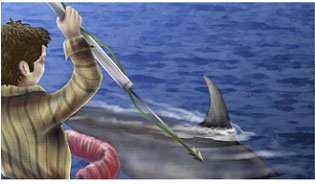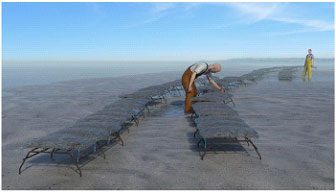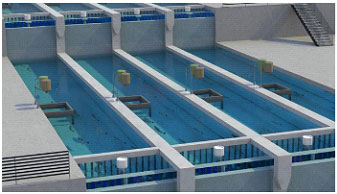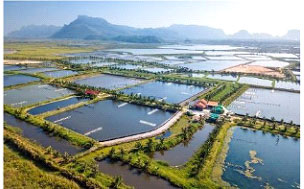
Fisherman use a wide range of gear to land their catch. By selecting the right gear for the right job, the fishing industry can minimize its impact on the ocean.
We will discuss the different types of fishing methods as well as touch on the different types of fish farming methods currently used in today’s aquaculture industry.
Beach and Boat Seines
Seines are long nets, with long ropes on each end, which herd fish when dragged or towed. They’re hauled over sandy or muddy bottom habitat, and the cloud of sediment helps herd the fish into the net. Seines are suspended vertically in the water with floats and weights, and some have a bag for catching fish. Beach seines are hauled in from the shore, while boat seines haul the catch onto the vessel. Danish seines, also known as “anchor seines,” are a type of boat seine

Bottom trawls are cone-shaped nets that are pulled along the seafloor by one or two boats to catch bottom-dwellers. Reducing the harmful effects of bottom trawling requires limiting when and where trawling can occur and gear modifications that allow unwanted marine life to escape and lessen impacts on the seafloor.

Dredges are metal-framed baskets that are dragged across the seafloor to collect shellfish. Towed dredges scrape or dig into the substrate with rakes or teeth to about a foot in depth. Mechanized dredges are used to dig and wash out mussels that have buried into the seabed. There are also hand-held dredges

Gillnets are walls of stationary or drifting netting that are almost invisible to fish, so species like cod, perch, salmon, sardines and trout swim right into them. Set, drift and trammel gillnets use different configurations of floats and weights to suspend the netting more or less vertically. Encircling gillnets are set in shallow waters, and noise or another means is used to entangle the fish in the netting. Fix gillnets are stretched between two or more stakes that are driven into the seabed in the intertidal zone.

Handlines are used to catch species like tuna, snapper and grouper. They can be a single fishing line, hook and bait or a mainline with several branchlineswith baited hooks, which can be reeled in manually or mechanically. A jig is a type of grapnel (or grappling hook), which is attached to a fishing line. Jigging involves manually or mechanically moving the jig in the water to lure prey, and then quickly pulling or jerking the fishing line to hook fish. Jigging for squid is usually done at night with lights to entice them closer to the surface.

Harpoons are poles that have a steel point with one or more barbs at the end and usually a retrieving line. When a fisherman targets a fish, he thrusts or shoots the harpoon into the animal and hauls it aboard. This traditional fishing method is still used today by skilled anglers to catch pelagic predators such as bluefintuna and swordfish. Modern harpoons are shot by guns.

Longlineshave a central line, ranging anywhere from about a mile to 30 miles long, that’s strung with evenly spaced smaller lines with baited hooks. Drifting longlinesare used near the surface to catch pelagic fish like tuna and swordfish, and set longlinesare laid on or near the seafloor to catch bottom-dwellers like cod and halibut.

Midwatertrawls are cone-shaped nets that are pulled along in the midwaterzone to catch species such as krill, rockfish and smelt. Two boats or otter boards maintain the net’s horizontal opening, and floats and/or weights support its suspension. Midwatertrawlers vary in size, ranging from small ships to large industrial vessels that pull gigantic nets spanning the size of five football fields that are capable of catching an entire school of fish.

Pole-and-lines are poles with a single line, hook and bait that are used to catch a variety of fish ranging from open-ocean swimmers like tuna to bottom-dwellers like cod. They can be hand-operated or mechanized when operating in deep waters.

Pots are cages or baskets that hold species such as lobsters, crabs and Pacific cod alive until fishermen return to haul in the catch. Pots have one or more openings and are used with or without bait. The second opening allows fish or species that are below the legal catch size to escape. They’re usually placed on the seafloor, but some are designed to be in midwater.

Purse seines use a large wall of netting to encircle schools of fish. Fishermen pull the bottom of the netting closed—like a drawstring purse—to herd fish into the center. This method is used to catch schooling fish, such as sardines, or species that gather to spawn, such as squid. Floating object purse seines use natural or artificial fish aggregating devices, or FADs, to attract schools of tuna.

Trolling lines catch species such as salmon, mahimahiand albacore tuna by luring them with moving fishing lines baited with hooks. Several trolling lines are often towed at the same time, and outriggers keep the lines away from the vessel’s wake. The lines can be hauled in by hand or mechanically.

Bottom culture involves growing mussels, oysters, scallops and clams on the seabed and harvesting them by hand, rakes or dredging. Seaweed may also be grown by bottom culture

Flow through raceways allow farmers to divert water from a waterway, like a stream or well, so it flows continuously through channels containing fish. These long and linear containment structures can be indoor or outdoor and are usually above ground in a terraced configuration.

Marine and freshwater net pens are enclosed on the bottom and sides by wooden, mesh or net screens, and submersible net pens are fully enclosed by mesh or net screens. Net pens are open systems that are in direct contact with the surrounding environment. Salmon, tilapia and tuna are a few of the species that are farmed in net pens

Off-bottom culture involves growing shellfish like mussels, oysters and scallops in suspended or off-bottom systems. In bag culture, juvenile shellfish, or “spat,” are cultivated in mesh bags that are attached to trestles placed in the intertidal zone. In raft culture, old shells are strung on strings and attached to floating raft structures. After spat have settled on the shells, the rafts are anchored in favorable growing areas. In longlineculture, spat are grown on ropes or in containers that are suspended from anchored or buoyed surface or subsurface ropes.

Ponds enclose fish and crustaceans in a coastal or inland body of fresh or salt water. They vary considerably from simple, extensive farms to high-tech, hyper-intensive farms with much higher production per hectare and use of supplemental feeds

Recirculating tanks have continuous water flow, and the wastewater is pumped through treatment systems that clean the water before returning it to the tank. These systems can be indoor or outdoor, and they’re usually above ground.



